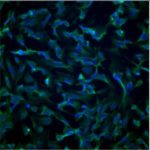Link to Pubmed [PMID] – 11724801
J. Biol. Chem. 2002 Feb;277(5):3132-40
To achieve a sequence-specific DNA cleavage by topoisomerase I, derivatives of the antitumor drug camptothecin have been covalently linked to triple helix-forming oligonucleotides that bind in a sequence-specific manner to the major groove of double-helical DNA. Triplex formation at the target sequence positions the drug selectively at the triplex site, thereby stimulating topoisomerase I-mediated DNA cleavage at this site. In a continuous effort to optimize this strategy, a broad set of conjugates consisting of (i) 16-20-base-long oligonucleotides, (ii) alkyl linkers of variable length, and (iii) camptothecin derivatives substituted on the A or B quinoline ring were designed and synthesized. Analysis of the cleavage sites at nucleotide resolution reveals that the specificity and efficacy of cleavage depends markedly on the length of both the triple-helical structure and the linker between the oligonucleotide and the poison. The optimized hybrid molecules induced strong and highly specific cleavage at a site adjacent to the triplex. Furthermore, the drug-stabilized DNA-topoisomerase I cleavage complexes were shown to be more resistant to salt-induced reversal than the complexes induced by camptothecin alone. Such rationally designed camptothecin conjugates could provide useful antitumor drugs directed selectively against genes bearing the targeted triplex binding site. In addition, they represent a powerful tool to probe the molecular interactions in the DNA-topoisomerase I complex.

